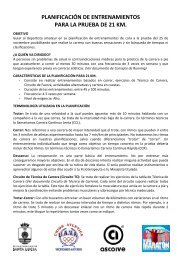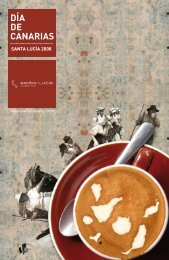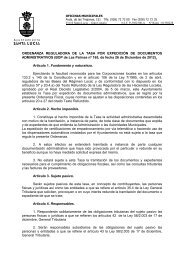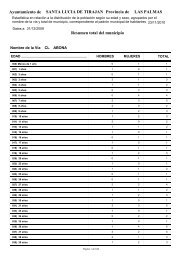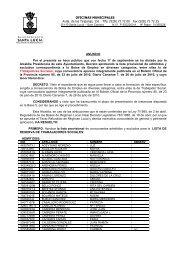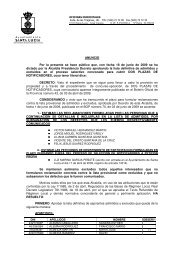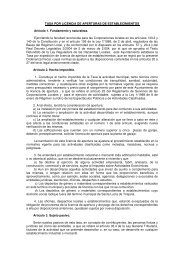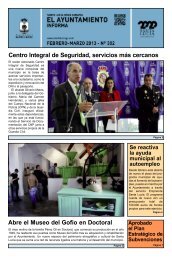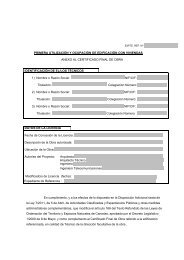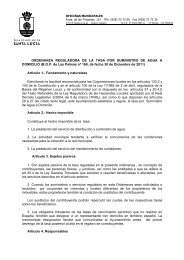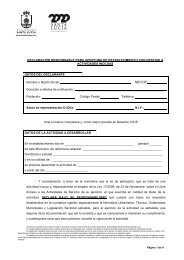Catalogo de la exposición.
Catalogo de la exposición.
Catalogo de la exposición.
You also want an ePaper? Increase the reach of your titles
YUMPU automatically turns print PDFs into web optimized ePapers that Google loves.
DARK CAMERA: ART AND PHOTOGRAPHYNowadays the stenopeic photography is a highly topicalsubject for several reasons since the mid-sixties when someartists with no connection started to experiment with thepinhole technique. Paolo Gioli (Italy) is maybe one of themain exponents together with others such as Gottfried Jäger(Germany), David Lebe, Franco Salmoiraghi, Wiley San<strong>de</strong>rsonand Eric Renner in the U.S.A.Many of these artists coinci<strong>de</strong>d by working on multiplepin head technique at a time. Wiley San<strong>de</strong>rson was photographyteacher at Georgia University and his lessons on stenopeicphotography ranged from 1953 to 1988. During that timehis stu<strong>de</strong>nts built 4356 stenopeic cameras. If we take thehistory of photography and especially what is re<strong>la</strong>ted to thestenopeic technique into consi<strong>de</strong>ration, we can gather thatalthough this technique has been somewhat ostracized frommost photography circles, it has never gone unnoticed. Withthe arrival of new technologies we have verified that thisphotographic technique is still in force, not only has its usebeen promoted in the world of art, but also in commercialphotography and fashion, due to the attractive mysteriousaesthetics which it projects.The present trend is the raising <strong>de</strong>mand of this techniquein schools of both artistic and professional photography.Although this artistic process is the principle of more than150 years of photography, as you can see in this exhibitionmagic and the post-process infinite creative possibilities <strong>de</strong>finitelyframe the stenopeic photography as a mo<strong>de</strong>rn alternativetechnique with a promising future.CÁMARA OSCURA: ARTE Y FOTOGRAFÍAHoy en día <strong>la</strong> fotografía estenopeica está <strong>de</strong> actualidad por múltiplesrazones <strong>de</strong>s<strong>de</strong> que a mediados <strong>de</strong> los años setenta varios artistas sin conexiónalguna comenzaron a experimentar con <strong>la</strong> técnica <strong>de</strong>l agujero <strong>de</strong> alfiler. Po<strong>de</strong>mos<strong>de</strong>stacar a Paolo Gioli (Italia) como uno <strong>de</strong> los principales exponentes y a otroscomo Gottfried Jäger (Alemania),David Lebe, Franco Salmoiraghi, WileySan<strong>de</strong>rson y Eric Renner en los E.E.U.U.Coinci<strong>de</strong>ntemente, muchos <strong>de</strong> estos artistas trabajaban con agujeros <strong>de</strong>alfiler múltiples. Wiley San<strong>de</strong>rson era profesor <strong>de</strong> fotografía en <strong>la</strong> universidad<strong>de</strong> Georgia y sus enseñanzas sobre fotografía estenopeica abarcaron un período<strong>de</strong>s<strong>de</strong> 1953 a 1988. Durante ese tiempo sus estudiantes construyeron 4356cámaras estenopeicas. Si observamos un poco <strong>la</strong> historia <strong>de</strong> <strong>la</strong> fotografía y enlo que se refiere a <strong>la</strong> técnica estenopeica po<strong>de</strong>mos observar que nunca hapasado <strong>de</strong>sapercibido aunque se haya notado cierta marginación en <strong>la</strong> mayoría<strong>de</strong> los círculos fotográficos. Con <strong>la</strong> llegada <strong>de</strong> <strong>la</strong>s nuevas tecnologías hemosconstatado que esta técnica fotográfica sigue vigente y se ha potenciado el uso<strong>de</strong> <strong>la</strong> misma no solo en el mundo <strong>de</strong>l arte, también en <strong>la</strong> fotografía publicitariay <strong>la</strong> moda, por <strong>la</strong> estética misteriosa y atractiva que proyecta.La trayectoria actual es <strong>la</strong> <strong>de</strong>manda creciente <strong>de</strong> esta técnica en escue<strong>la</strong>s<strong>de</strong> fotografía artística y <strong>de</strong> profesionales <strong>de</strong> <strong>la</strong> misma.Aunque este procedimiento artístico es <strong>la</strong> base o principio <strong>de</strong> más <strong>de</strong> 150años <strong>de</strong> fotografía, como pue<strong>de</strong>n observar en esta muestra <strong>la</strong> magia y <strong>la</strong>sinfinitas posibilida<strong>de</strong>s creativas post-proceso enmarcan <strong>de</strong>finitivamente a <strong>la</strong>fotografía estenopeica como técnica alternativa <strong>de</strong> actualidad y con un futuroprometedor.Ricardo Montes<strong>de</strong>oca




